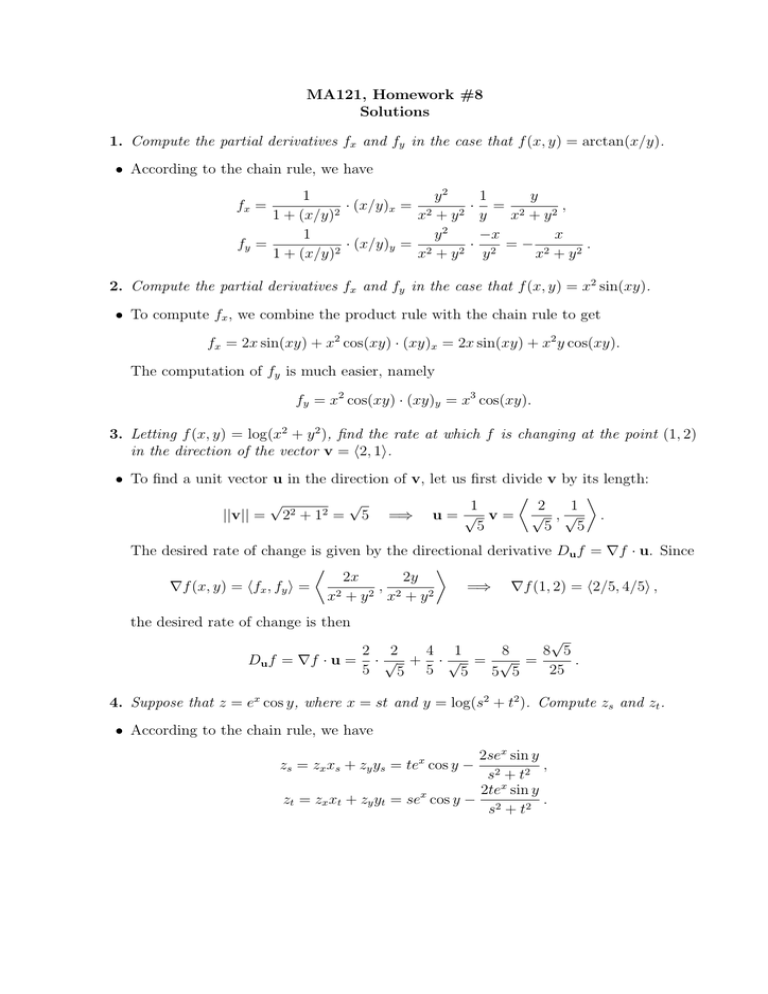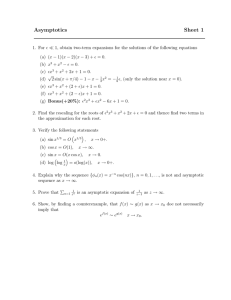MA121, Homework #8 Solutions Compute the partial derivatives f 1
advertisement

MA121, Homework #8 Solutions 1. Compute the partial derivatives fx and fy in the case that f (x, y) = arctan(x/y). • According to the chain rule, we have y2 1 · (x/y) = x 1 + (x/y)2 x2 + y 2 y2 1 · (x/y) = fy = y 1 + (x/y)2 x2 + y 2 fx = 1 y = 2 , y x + y2 −x x · 2 =− 2 . y x + y2 · 2. Compute the partial derivatives fx and fy in the case that f (x, y) = x2 sin(xy). • To compute fx , we combine the product rule with the chain rule to get fx = 2x sin(xy) + x2 cos(xy) · (xy)x = 2x sin(xy) + x2 y cos(xy). The computation of fy is much easier, namely fy = x2 cos(xy) · (xy)y = x3 cos(xy). 3. Letting f (x, y) = log(x2 + y 2 ), find the rate at which f is changing at the point (1, 2) in the direction of the vector v = h2, 1i. • To find a unit vector u in the direction of v, let us first divide v by its length: ¿ À √ √ 1 2 1 ||v|| = 22 + 12 = 5 =⇒ u = √ v = √ , √ . 5 5 5 The desired rate of change is given by the directional derivative Du f = ∇f · u. Since ¿ À 2x 2y ∇f (x, y) = hfx , fy i = , =⇒ ∇f (1, 2) = h2/5, 4/5i , x2 + y 2 x2 + y 2 the desired rate of change is then √ 2 2 4 1 8 8 5 Du f = ∇f · u = · √ + · √ = √ = . 5 25 5 5 5 5 5 4. Suppose that z = ex cos y, where x = st and y = log(s2 + t2 ). Compute zs and zt . • According to the chain rule, we have 2sex sin y , zs = zx xs + zy ys = te cos y − 2 s + t2 2tex sin y zt = zx xt + zy yt = sex cos y − 2 . s + t2 x 5. Suppose that f = f (u, v, w), where u = x − y, v = y − z and w = z − x. Assuming that all partial derivatives exist, show that fx + fy + fz = 0. • First of all, we use three applications of the chain rule to get fx = fu ux + fv vx + fw wx = fu − fw , fy = fu uy + fv vy + fw wy = −fu + fv , fz = fu uz + fv vz + fw wz = −fv + fw . Once we now add these three equations, we find that fx + fy + fz = 0, indeed.



